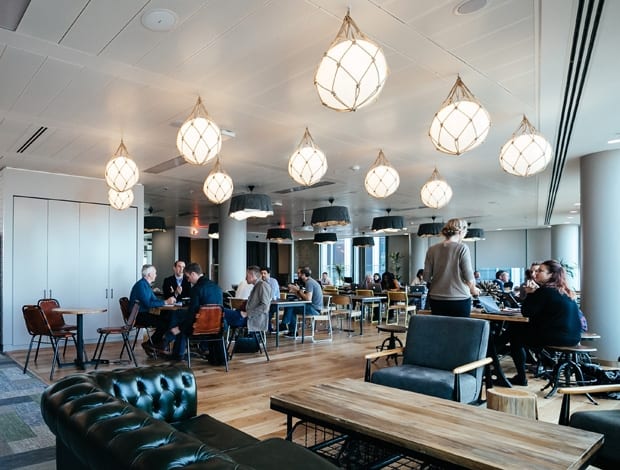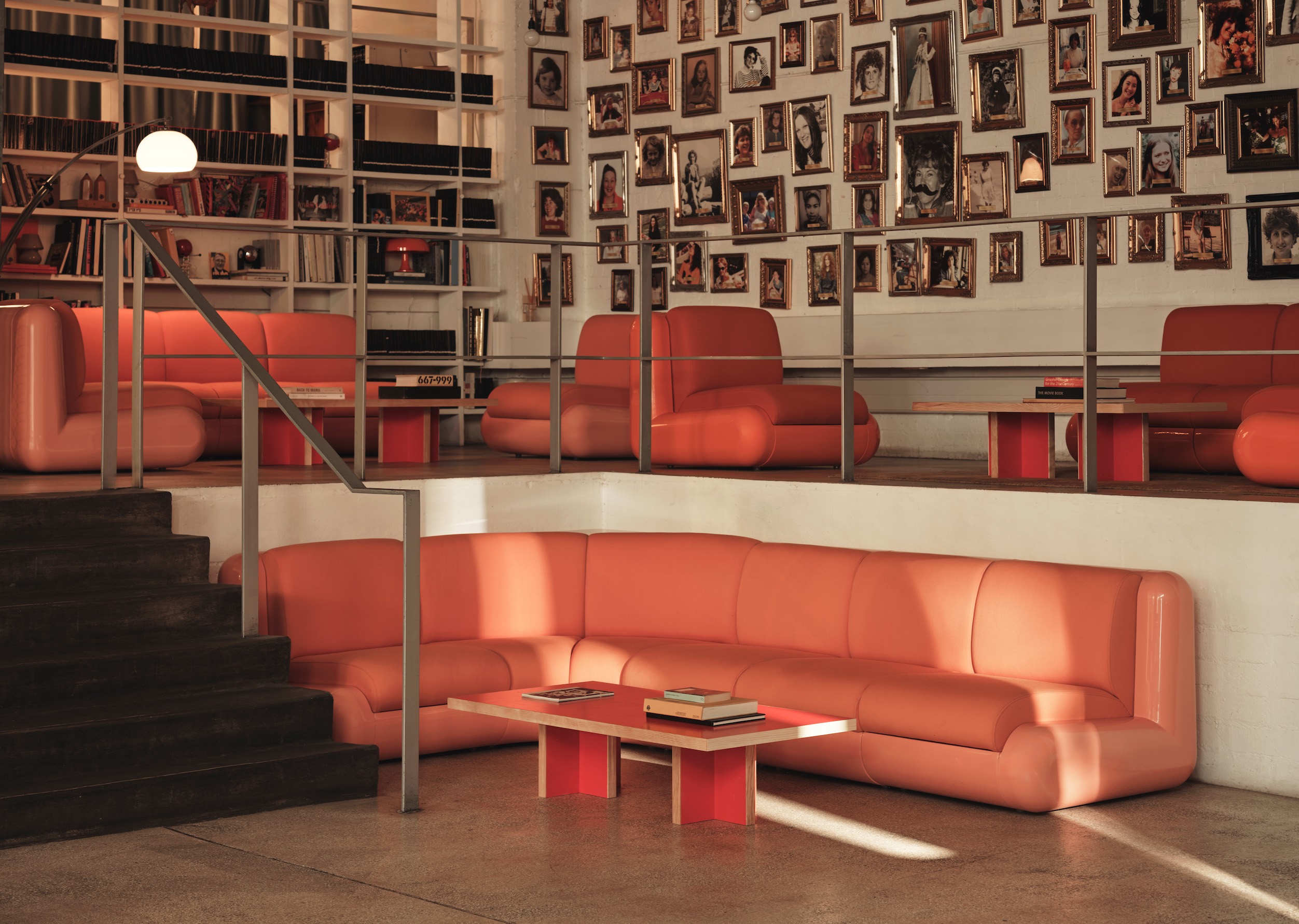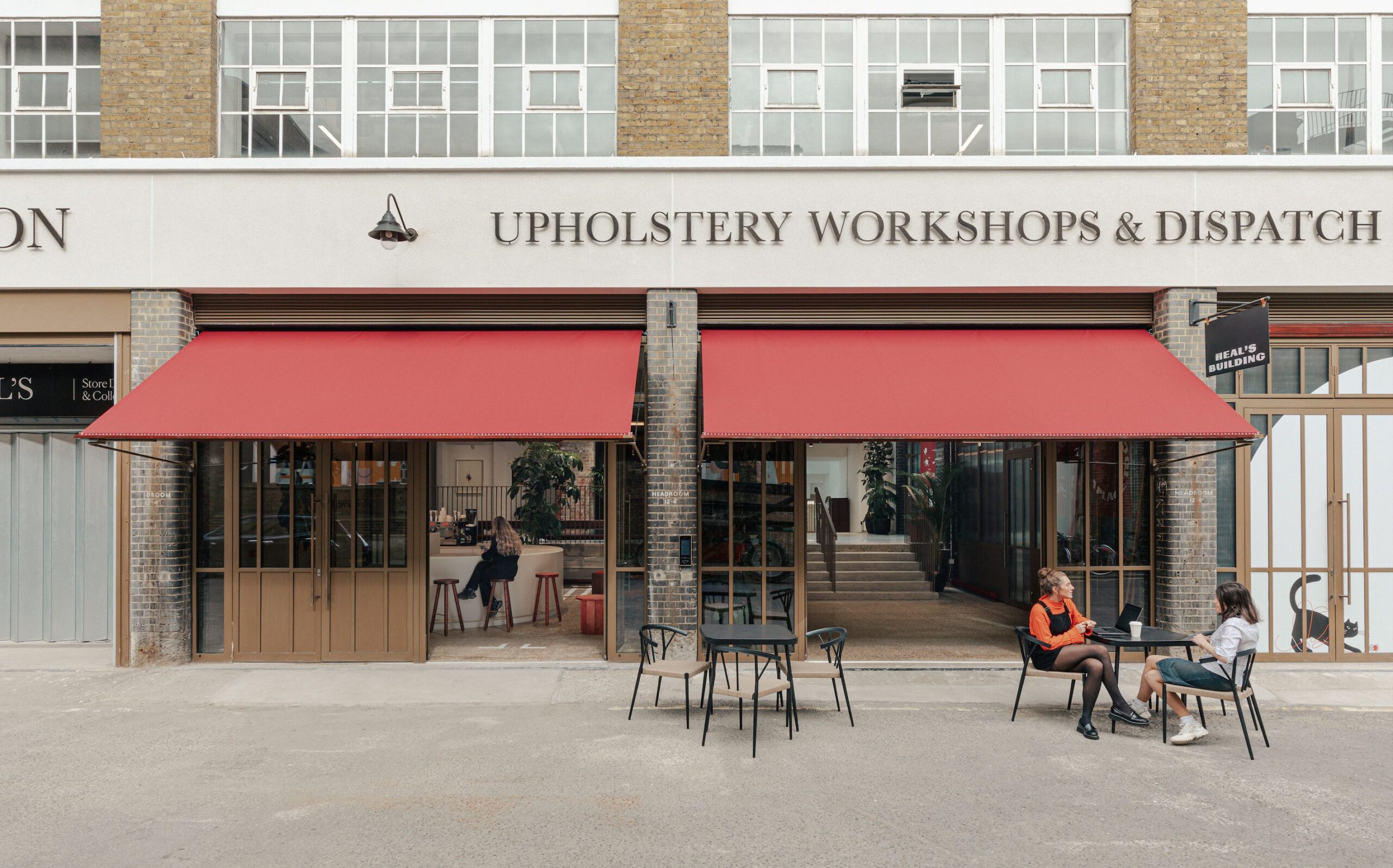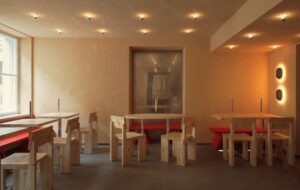 US import WeWork has set up in Sea Containers House|WeWork’s £325 per month fee includes access to a database of 15,000 other WeWorkers|WeWork’s private space complements communal work areas|Islington’s Hub quickly expanded to become a global brand|The Hub in Islington has a community focus, hosting regular events|TP Bennett’s WeWork interiors should appeal to creatives|Co-working has become big business: WeWork is valued at $5bn|The Islington Hub: a decade old, its cheeky DIY approach marked the birth of something new||
US import WeWork has set up in Sea Containers House|WeWork’s £325 per month fee includes access to a database of 15,000 other WeWorkers|WeWork’s private space complements communal work areas|Islington’s Hub quickly expanded to become a global brand|The Hub in Islington has a community focus, hosting regular events|TP Bennett’s WeWork interiors should appeal to creatives|Co-working has become big business: WeWork is valued at $5bn|The Islington Hub: a decade old, its cheeky DIY approach marked the birth of something new||
The small-scale, DIY ethos that gave birth to the first collaborative workspaces has in ten years grown up into something far more polished. Can this multi-million-pound industry hold on to its radical roots?
We live in an age of sharing. From a sad-faced cat posted on Instagram to a 140-character barrage directed towards a company’s customer services, the casual regularity with which we broadcast our lives is unprecedented. Technology is the driver behind this slightly daunting level of openness, expanding our network of friends and business contacts far beyond our immediate circles. The vast majority of Linkedin connections, for example, will be people you have never met, yet through the steady automated collections of data their network has intersected with yours.
Inevitably, how we do business is changing too. An entrepreneur is as likely to ask the audience, gameshow-style, to secure new business funding as they are a bank. Similarly, pharmaceutical giants like Pfizer and GSK have crowd-sourced research despite operating in a world determined by intellectual property rights. Coupled with technology finally delivering on its promise that we could work any time, any place, anywhere, the impact on our working lives has been transformative.
Architects Gensler coined the term Generation S to define this new companionate attitude. And whereas previous generations might have aspired to climb the career ladder within a large corporation, the S-ers are more interested in forging their own path. The result is a polarisation between the spheres of the individual and the corporation. “We are moving into a barbell economy where you have large companies on one side and a whole bunch of contingent workers that could make up 40% of the workforce,” says Gensler principal Philip Tidd. The physical space where these two entities meet is increasingly in shared co-working spaces.
Far from a new concept, the co-working movement has been around for ten years, born of a Janus-headed assemblage of frustration and necessity. If you were starting a business in London, for example, you had two options: work from home or take space in a serviced office that conveyed nothing about your business or values. Feeling there was a better alternative, groups of friends who had studied or worked together simply built their own workspaces in a city’s forgotten nooks. A collaborative ethos was thus written into the DNA of early co-working spaces reaching beyond cheap rent and dodging the fixed-lease albatross. From its grassroots beginnings it has evolved with startling velocity into a multi-million pound global industry with a variety of interpretations – from the ultra exclusive NeueHouse by the Rockwell Group to WeWork‘s broader church.
The corporate world has taken note. “There is a growing and genuine interest in the concept of corporate co-working,” says Tidd. “They are realising that if they can provide a facility that opens up to other organisations it might be a way of stimulating innovation within their own organisation. The idea of sharing real estate will gather pace.”
Designer Oliver Marlow was there at the beginning, working on the first Hub space in a former photographer’s studio in Islington in 2004. It evolved into a global phenomenon, but it nevertheless encapsulates the radical spirit of the early years. “We had all had a go at London in our own way,” he says. “I had a studio in Hackney Wick in 2001 and it was terrible – no hot water, that kind of thing. We all came back together and said we need to think about this more collectively.”
The Hub’s original founders came from a wide breadth of disciplines – architect Katy Marks, Jonathan Robinson an anthropologist, linguist Eithne Flanagan and Mark Hodge a historian and economist formed the core around which grew a loose collection of techies, graphic designers and charity workers. “We designed and built everything ourselves. We spent the winter of 2004 putting the materials together and thinking up a design that felt workable. At one point, it got so cold that the glue we were using froze.” Environmental challenges aside, the Hub proved a success and Marlow went on to repeat the formula creating a wave of Hubs across the world (the brand has since been renamed Impact Hub).
Co-working’s grand accelerator arrived in the shape of the 2008 global financial crisis, which prompted a mass culling of company staff. Whether people jumped or were shoved, the net result was a market flooded with skilled but career-challenged professionals. With steady jobs in short supply, many started their own companies – and co-working spaces, then still in their infancy, proved to be fertile ground for these fledgling entrepreneurs.
The Islington Impact Hub is still going, its rough and ready aesthetic, which became synonymous with co-working, enduring ten years of hard use. Back then, the DIY designs mirrored the low-budget, organic nature of the movement but what has emerged is altogether more polished. Take Gensler’s Level39 in Canary Wharf. Opened in 2012, it is part of a second wave of co-working spaces designed to appeal to corporate types who would baulk at a place like the Hub. Level39 was devised by the man behind Tech City UK, Eric van der Kleij, as part of a long-term strategy to fuse the realms of finance and the booming digital economy.
Tidd says that his client “wanted to create a space where anything and everything to do with the digital economy can meet financiers who can fund a venture or give advice on how to grow. A place where these two worlds come together. There are all sorts of different demographics there, from graduates who have started a business with a friend to investment bankers.”
Level39 is representative of a new, more professional approach to co-working. Design-wise there is nothing here to scare off the moneymen and the IT systems are efficient enough to attract the tech-savvy innovators. It has proved such a success that the Canary Wharf Group will expand its offering with Wood Wharf – the next phase of development ambitiously labelled Innovation City.
Workplace R&D specialist Jennifer Magnolfi, who counts Herman Miller among her clients, says that co-working “is more aligned with the way 21st-century workers work. It has come full cycle so it has been internalised, adopted and therefore transformed, and we have seen many different forms evolve, whereas just a few years ago it was a small growing phenomenon.”
Around the same time as Oliver Marlow was considering the freezing point of industrial adhesive, another ambitious operator, this time hailing from a property background, was dealing with his own frustrations with the one-dimensional London office market. Charlie Green, who co-founded the Office Group with business partner Olly Olsen 12 years ago, had an initial idea to challenge the serviced office sector. What they ended up doing was shifting the perception of what a mainstream office should be, with a series of adroit collaborations with architects in unusual and sometimes – as with their own headquarters in the Richard Seifert-designed One Euston Square – unfashionable parts of the city.
Put simply, the Office Group offers flexible workspace in well-designed surroundings and, crucially, access to a wide network of different businesses via its co-working ClubSpace. With the Office Group, the building came first, followed by the community, the opposite path taken by the Hub, but both have arrived at a similar place.
When I go to meet Green in the aforementioned slab of 1960s modernism, his labelling of the space as an eco-system begins to make sense. In contrast to the building’s generic reception, the Office Group’s own front of house is buzzing and slightly quirky. All around us are little groups of people (some suited, others not), hunkering around low-slung coffee tables. It’s an alphabet soup of generational stereotypes – X, Y and Z – but what is striking is the collusion between these two groups. Green reveals that two major tenants are Santander and Virgin.
“There is an energy in the building that you would not be able to get in a one-company monoculture,” he says. “What has changed is that whereas before a corporate would have approached a big agency to work on their website, because they had the resources, now they will happily use a one-man band because the technology allows it.”
This creative frisson between jocks and nerds epitomises the co-working blueprint as advocated by its enthusiasts. Sceptics might suggest that people would automatically graduate towards those like themselves, perpetuating the kind of dysfunctional, siloed culture often found in traditional office space. On hand to ensure this state of affairs does not arise is a singular figure – the office equivalent of the casino greeter – whose primary function is to connect the various groups. Need an accountant? Step right this way.
Tweaks required to your website? Meet this guy. This freewheeling enabler does not exist within the boundaries of a normal workplace, but here they are a vital component. Co-working is as effective only in as much as the community is cohesive. If no one talks, it fails, but in determining whether the arguments for it stacked up, Gensler discovered that 87% of co-workers had collaborated with a peer sharing the space.
Needless to say, Green understands that the vitality of his business, which is forecast to turnover more than £50m this year, is enlivened by the careful nurturing of these spaces. This year, the doors will be opening on the Office Group’s most ambitious project to date, the revamp of Henry Wood House in London’s West End. Designed by regular collaborator BuckleyGrayYeoman, the new workspace will ramp up the social side of things with a members’ bar, gym and a library. Despite being some way removed from the glassy domain of finance and its CNC-milled ancestors, Green is keenly aware of its growing appeal to both their traditional inhabitants.
Another company casting its net wide is American giant WeWork, which arrived in London last autumn and is valued at $5bn. Founder Miguel McKelvey shunned the fashionable East End – co-working’s spiritual home – for the South Bank’s newly overhauled Sea Containers House, most notable as the vessel for Tom Dixon‘s hip Mondrian Hotel. Extending over five floors, WeWork is a mixture of co-working, office space and appealing social areas. The more traditional office is a very American take on workspace with people enclosed in a variety of glass boxes rather than an open-plan set up.
“We found that people had limited endurance for working in a space where everyone could hear everything,” McKelvey’s disembodied voice beams in to one of WeWork’s many timber-clad meeting rooms. “That openness applied well to the computer programmer who sat with his headphones on all day, but for people in mixed industries, sales people – well, it just rules a lot of people out.”
This cuts to the heart of WeWork’s deliberately broad appeal. McKelvey began his career at a dotcom start-up, his experiences renting office space in Brooklyn convincing him that if he
could combine the professionalism of a serviced office with a “really cool vibe” he might latch on to something far more universal.
“Not only would it suit us because we were in a start-up, it would suit everyone around us who was in the same boat,” he says. What sets WeWork apart is its lusty embrace of technology. Anyone joining (currently £325 per month in London) has immediate access to its app, which provides contact details, a thumbnail photo and a short biography of the 15,000 other WeWorkers.
Using technology to expand the community beyond the physical space seems like a logical extension to co-working, and taps into an idea often mooted but as yet untested in any organised manner – the city as office. We are just now seeing tentative steps towards this reality. Barclays recently announced it was giving over its unused office space to entrepreneurs in an incubator scheme called Hatch, presumably to court the bright young things that may take the space.
In the US, organisations like LiquidSpace follow a kind of Airbnb model where companies rent their unused offices and meeting rooms for a daily or hourly rate, flipping on its head the idea of real estate as a cost. In cities where office space often comes at an eye-watering price, the idea of sharing your workspace with a number of related but not necessarily competitive businesses, thereby harnessing the shared knowledge that might bring, seems an attractive proposition. At least, in theory.
To happen, it would need not just a wholesale rejection of the old ‘command and control’ style of management, but a general shake up of the property industry itself. For despite co-working’s rise, the model is still long-term rent with a long-term occupier. So for the moment it is unlikely that, say, RBS is about to abandon its Bishopsgate headquarters and decant its workforce into co-working spaces across London. Although, with the launch of technologies like smart eyewear the boundaries between the office and city at large will continue to merge, the idea of fully augmented co-working society may never arrive. However, notions of collaboration, chance encounters and ‘engineering serendipity’ have nevertheless permeated the mindset of even the most pedestrian of businesses – and this can no doubt be traced to co-working.



















